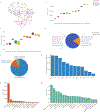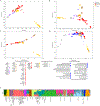Whole-genome sequencing reveals a complex African population demographic history and signatures of local adaptation
- PMID: 36868214
- PMCID: PMC10568978
- DOI: 10.1016/j.cell.2023.01.042
Whole-genome sequencing reveals a complex African population demographic history and signatures of local adaptation
Abstract
We conduct high coverage (>30×) whole-genome sequencing of 180 individuals from 12 indigenous African populations. We identify millions of unreported variants, many predicted to be functionally important. We observe that the ancestors of southern African San and central African rainforest hunter-gatherers (RHG) diverged from other populations >200 kya and maintained a large effective population size. We observe evidence for ancient population structure in Africa and for multiple introgression events from "ghost" populations with highly diverged genetic lineages. Although currently geographically isolated, we observe evidence for gene flow between eastern and southern Khoesan-speaking hunter-gatherer populations lasting until ∼12 kya. We identify signatures of local adaptation for traits related to skin color, immune response, height, and metabolic processes. We identify a positively selected variant in the lightly pigmented San that influences pigmentation in vitro by regulating the enhancer activity and gene expression of PDPK1.
Keywords: African demographic history; African genomics; Khoesan; archaic introgression; gene regulation; human evolution; local adaptation; natural selection; population structure; skin color.
Copyright © 2023 Elsevier Inc. All rights reserved.
Conflict of interest statement
Declaration of interests The authors declare that they have no competing interests.
Figures







References
-
- Blench R (2006). Archaeology, Language, and the African Past (Rowman Altamira; ).
-
- Heine B, and Nurse D (2000). African Languages: An Introduction (Cambridge University Press; ).
Publication types
MeSH terms
Substances
Grants and funding
LinkOut - more resources
Full Text Sources
Molecular Biology Databases
Miscellaneous

